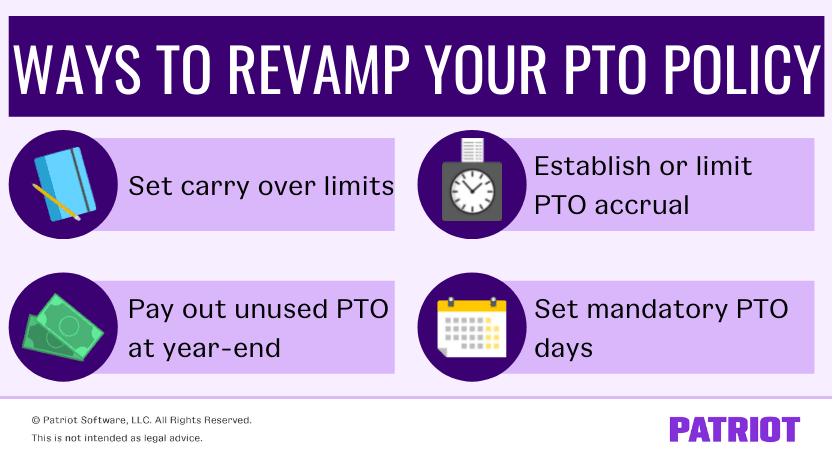As an employer, you may decide to establish a paid time off (PTO) policy for your employees that they can use for vacation, personal days, sick time, etc. At some point, you may decide that you want to tweak your current policy. But, how do you go about changing your business’s PTO policy? And, can you change PTO policies mid-year? Get the full scoop below.
Can you change PTO policies mid-year?
With so much uncertainty due to COVID-19, many employees are holding off on taking PTO until more restrictions are lifted. Plus, a good chunk of employees have put vacation time on the backburner thanks to being able to work from home. In fact, according to one study, 42% of businesses have already made or are planning changes to PTO policies because of the current climate.
To incentivize employees to take their well-deserved paid time off, you may decide to shake up your business’s PTO policy. But, can you do such a thing in the middle of the year? Or what about at any time throughout the year?
The answer? Yes, you can make PTO policy changes whenever you want during the year. However, if you make any changes, they cannot:
- Affect employees’ current and/or accrued paid time off benefits
- Go against any federal, state, or local laws
Before you make any changes to your PTO policy, make sure you do your research to ensure your policy changes do not break any laws.
Can employer change vacation policy without notice?
Employers are not required by law to give employees notice before changing a vacation or paid time off policy. However, it’s best practice to give your employees a heads up. That way, they know changes are coming their way and can make adjustments ahead of time, if needed.
Want to impress your friends at a dinner party?
Get the latest payroll news delivered straight to your inbox.
Subscribe to Email ListRevamping your company PTO policy
Maybe you’re thinking about changing up your PTO policy due to COVID. Or, maybe you’re just ready to shake things up or try something new, like leave donation. Whatever your reason may be, here are a few ways you can revamp your PTO policy and encourage employees to take time off.
Set carry over limits
One way you can switch up your policy is by either:
- Setting PTO carryover limits
- Tweaking your current carryover rules
Some companies allow employees to carry over unused PTO into the new calendar year. To encourage employees to use paid time off, you can set a carryover limit (e.g., no more than 40 hours can be carried over).
If you currently have carryover rules in your policy, you can also revise them. For example, maybe you currently allow employees to carry over up to 60 hours of PTO but decide you want to limit it to 40 hours.
If you decide to set carryover rules or revise your current carryover cap, check state laws first to ensure you are compliant.
Pay out unused PTO at year-end
Another way to switch up your PTO policy is by paying out unused PTO hours at the end of the year.
Like with carrying over hours, you may set a limit for how many hours you pay out to employees (e.g., 40 hours).
Paying out employees for unused hours is a win-win. It encourages employees to use a chunk of their PTO while also not forcing them to take time off.
Establish or limit PTO accrual
Depending on your business, you may decide to establish a PTO accrual policy for employees. Or if your company currently has a PTO accrual rule, you may decide to tweak it so employees can accrue more (or less) time.
For example, you may decide that employees can accrue one hour of PTO for every 40 hours worked. And, you set a maximum accrual amount of 40 hours per year per employee.
When setting accrual limits, try to make the limits as reasonable as possible. Do your research to find out what other companies in similar industries offer when it comes to PTO accruals.
PTO accruals can encourage employees to save up time and use accrued PTO for days off.
Keep in mind that you need to follow PTO payout laws by state when it comes to paying out, rolling over, using, or forfeiting accrued PTO. Check your state’s laws to find out PTO payout requirements.
Set mandatory PTO days
As an employer, you might also decide to make taking PTO days mandatory—especially if your employees aren’t taking advantage of the time off.
Making a certain amount of PTO mandatory (e.g., use 40 hours by June 30) can motivate employees to take time off to unwind and recharge. Not to mention, it can help boost your workplace’s productivity. And, it can help ensure that your employees use their earned paid time off throughout the year.
But, keep in mind that making PTO mandatory may result in disgruntled employees. So, use caution when requiring employees to take PTO.

Steps to change your PTO policy
Ready to give your PTO policy a little makeover? To make PTO policy changes, follow the steps below:
- Decide what you want to change or add
- Do your research to make sure your policy is compliant with laws
- Rewrite your policy
- Inform employees of any new changes
After changing your PTO policy…
If you make updates to your PTO policy for any reason (doesn’t have to just be COVID-related), make sure you inform all employees about any changes.
To keep all employees in the loop about policy revisions, make sure you send out a PTO policy change announcement. You can include the policy changes in an email or internal newsletter. Or, you can opt to have a meeting to discuss the policy updates.
Whatever you do, be sure to keep employees well-informed about the revamped policy. And, give employees an opportunity to ask you questions about the revisions.
Along with announcing any new changes to your policy, make sure you update your employee handbook accordingly.
On the hunt for an easy way to track your employees’ paid time off? You’ve come to the right place. Patriot’s online time and attendance software add-on integrates seamlessly with our payroll software. Try both for free today!
This is not intended as legal advice; for more information, please click here.



